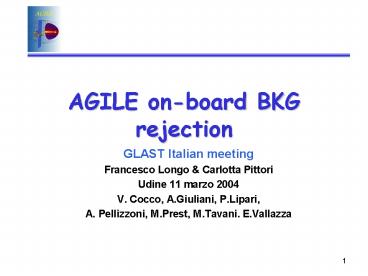GLAST Italian meeting PowerPoint PPT Presentation
1 / 13
Title: GLAST Italian meeting
1
AGILE on-board BKG rejection
- GLAST Italian meeting
- Francesco Longo Carlotta Pittori
- Udine 11 marzo 2004
- V. Cocco, A.Giuliani, P.Lipari,
- A. Pellizzoni, M.Prest, M.Tavani. E.Vallazza
2
DETECTOR DESCRIPTION
- Top Anticoincidence
- Lateral Anticoincidences
- SuperAGILE
- Silicon Tracker
- Mini-Calorimeter
- Mechanical structure
- (not shown in the figure)
54 cm
15 cm
22 cm
5 cm
40 cm
3
Expected particle/albedo-photon background for an
Equatorial Orbit
- Particle flux from SAS-2 and BeppoSAX data (0.3
cm-2 s-1 for Ekin ? 1 MeV ) - 3 main components e, e-, p
- Spectral data from AMS and Marya
- Assumptions
- 1) isotropic distribution for e, e-, and
low energy protons - 2) sky-incidence for high energy p (Ekin ? 7
GeV ) - Albedo photons from the Earth (from SAS-2 data)
- Thompson et al. 1981
Longo, Cocco Tavani (2002)
4
Albedo Photons
- Thompson et al. 1981
5
Event Generation
- Particle/Albedo-photon Background
- Astrophysical point sources
- Particle/photon tracks originating on a spherical
surface - Montecarlo methods for the generation of the
distribution functions
AGILE Payload
Longo, Cocco Tavani (2002)
AGILE Satellite
6
Trigger Levels
- Hardware Implementation
- Information from Silicon Tracker and AC panels
- Track topology at the chip level
- Software Implementation
- Analog Information on the released charge in the
Si-microstrips - Track topology at the cluster level
- 3D-reconstruction to reject albedo photons
- Level-1
- Level-2
7
L1 - TRIGGER
R trigger concept
8
L1- TRIGGER
9
Charge deposition
Optimal spatial resolution 40 ?m for a broad
range of incidence angles (0?-50?)
50 MeV gamma-ray, ? 50?
10
Monte Carlo Simulations
Simulated background proton event
Simulated Gamma-Ray (E100 MeV, ?30º)
It can be rejected by the on-board trigger
because of the crucial use of the analog signal
from the Si-microstrips providing information on
cluster charges.
? direction from 3-D AGILE REconstruction Method
(AREM) integrated with Kalman filter algorithms
(Pittori-Tavani NIM 2002)
11
On-board GRID Background Rejection
- Particle background rates
- e/e- reduced by a
- factor 100
- Protons reduced by a
- factor 1000
- Earth albedo ?-ray flux
- reduced by a factor 30
The GRID on-board background rejection is quite
efficient, reducing the total charged-particle
rate from 2000 Hz to 20 Hz.
Cocco, Longo Tavani (2002)
12
SUMMARY OF ON-BOARD BACKGROUND REJECTION
- Expected total rate of particle/albedo-photon
- entering into the Tracker volume 2-3
KHz - Level-1Trigger cut ?100
Hz - Level-2 processing cut 20-30
Hz - On-board Background Rejection 10-2
13
Effective Area
Science with AGILE (2003)

